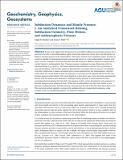| dc.contributor.author | Royden, Leigh H | |
| dc.contributor.author | Holt, Adam F | |
| dc.date.accessioned | 2022-02-01T19:02:08Z | |
| dc.date.available | 2021-10-27T19:56:59Z | |
| dc.date.available | 2022-02-01T19:02:08Z | |
| dc.date.issued | 2020-07 | |
| dc.date.submitted | 2020-05 | |
| dc.identifier.issn | 1525-2027 | |
| dc.identifier.uri | https://hdl.handle.net/1721.1/133847.2 | |
| dc.description.abstract | ©2020. American Geophysical Union. All Rights Reserved. Recent work suggests that slab dip may be controlled by differences in dynamic pressure above and below the slab at mid-asthenospheric depth, motivating exploration of how plate and slab motion are linked to dynamic pressure in the asthenosphere. This paper, the first of two companion papers, presents an analytical method for determining dynamic pressure and velocity in a thin asthenospheric channel, with linear viscosity, consistent with prescribed plate and slab kinematics. Slabs are explicitly incorporated as vertical barriers to asthenospheric flow. Dynamic pressure is expressed as sums of functions with two functional forms, Pedge and Pwall; the former generates discontinuities in velocity (but not pressure) at non-slab boundaries, and the latter generates discontinuities in pressure (but not velocity) at boundaries with slabs. Application to simple rectangular plate systems demonstrates that asthenospheric velocities within about one trench length of slabs are insensitive to processes on the opposing side of the slab, that dynamic pressure scales linearly with trench length for a given plate aspect ratio and scales approximately linearly with the shortest plate dimension. Although dynamic pressure is quasisymmetrical across convergent plate boundaries that lack slabs, the presence of slabs creates discontinuity and asymmetry in dynamic pressure across subduction zones. When flux of asthenosphere into the lower mantle occurs adjacent to subducting slabs, dynamic pressure is decreased on the side of the slab where down-flux occurs. This analytical method, applied to systems with multiple arbitrarily shaped plate boundaries, yields excellent results as benchmarked against 3-D numerical solutions. | en_US |
| dc.language.iso | en | |
| dc.publisher | American Geophysical Union (AGU) | en_US |
| dc.relation.isversionof | http://dx.doi.org/10.1029/2020GC009032 | en_US |
| dc.rights | Article is made available in accordance with the publisher's policy and may be subject to US copyright law. Please refer to the publisher's site for terms of use. | en_US |
| dc.source | Other repository | en_US |
| dc.title | Subduction Dynamics and Mantle Pressure: 1. An Analytical Framework Relating Subduction Geometry, Plate Motion, and Asthenospheric Pressure: 1. An Analytical Framework Relating Subduction Geometry, Plate Motion, and Asthenospheric Pressure | en_US |
| dc.type | Article | en_US |
| dc.contributor.department | Massachusetts Institute of Technology. Department of Earth, Atmospheric, and Planetary Sciences | |
| dc.relation.journal | Geochemistry, Geophysics, Geosystems | en_US |
| dc.eprint.version | Final published version | en_US |
| dc.type.uri | http://purl.org/eprint/type/JournalArticle | en_US |
| eprint.status | http://purl.org/eprint/status/PeerReviewed | en_US |
| dc.date.updated | 2021-09-21T17:47:11Z | |
| dspace.orderedauthors | Royden, LH; Holt, AF | en_US |
| dspace.date.submission | 2021-09-21T17:47:12Z | |
| mit.journal.volume | 21 | en_US |
| mit.journal.issue | 7 | en_US |
| mit.license | PUBLISHER_POLICY | |
| mit.metadata.status | Authority Work Needed | en_US |
